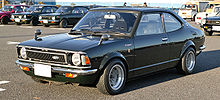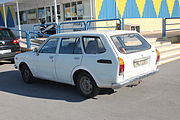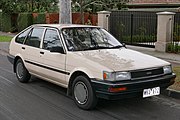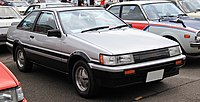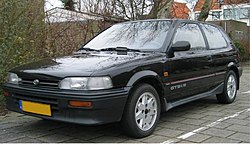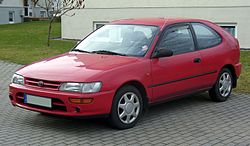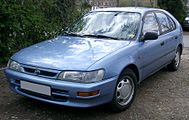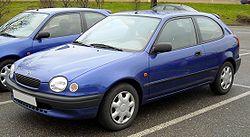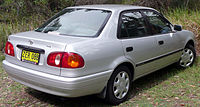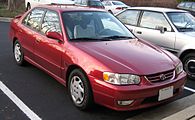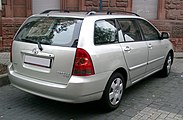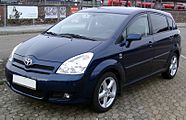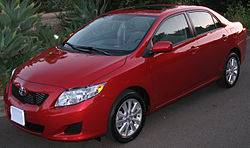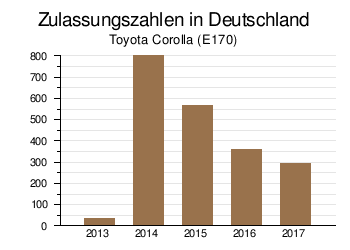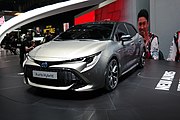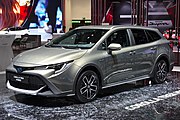Toyota Corolla
| Toyota Corolla | |
|---|---|
| Production period: | since 1966 |
| Class : | Lower middle class , compact class |
| Body versions : | Sedan , hatchback , station wagon , coupe , Combi Coupé |
Toyota Corolla is the model name for a car of the lower middle class , later the compact class , which has been used by the Japanese Toyota Motor Corporation for a number of different car models since mid-1966.
Over the course of time, the factory has derived a large number of different variants from the Corolla, which are often restricted to Japan and serve the purpose of serving the manufacturer's various sales networks. The best-known include the Corolla Sprinter (higher-end version) introduced in the summer of 1968, the Corolla Levin ( coupé versions) and the Sprinter Trueno (the coupé version of the Corolla E70 with rear-wheel drive ). The latest on offer was the Corolla Verso minivan .
While the Corolla was withdrawn from the main European markets ( Germany , France , Italy , Great Britain) in spring 2007 in favor of the Auris , the model series will continue to be marketed as Corolla in other markets in Europe and other continents. At the end of 2006 the tenth generation of the Corolla (E14) was presented, which was available in a notchback version (in Japan: Corolla Axis) and as a station wagon (Corolla Fielder).
The Toyota compact car has been sold worldwide as the Corolla again since 2019. The corresponding generation was presented as the Auris at the Geneva Motor Show 2018, and Toyota later announced the discontinuation of the model name. In 2020, the Toyota Corolla Cross sports utility vehicle based on this generation was presented.
In the course of the history of the model, cars with the name Corolla were not only manufactured in Japan , but in numerous other countries, for example in the USA , Canada , Brazil , Venezuela , China , Taiwan , Malaysia , Bangladesh , Pakistan , Turkey , Thailand and India , UK and the Philippines . In a joint venture with General Motors , the Corolla-based Chevrolet Nova and Chevrolet or Geo Prizm were manufactured in California . Also related to the Corolla was the charm of the Toyota Group manufacturer Daihatsu .
Around 46 million Corolla were manufactured by 2019.
General
The Toyota Corolla is the best-selling car in the world. However, there are ten model generations with some fundamental conceptual changes such as the switch from rear-wheel to front-wheel drive . Independent models have also been integrated into the Corolla series several times.
The Corolla is considered a very reliable car, which is also confirmed by breakdown statistics and the TÜV reports.
Corolla (E10, 1966-1970)
| 1st generation | |
|---|---|
|
Toyota Corolla |
|
| Production period: | 1966-1970 |
| Body versions : | Sedan , station wagon , coupé |
| Engines: |
Petrol engines : 1.1–1.2 liters (44–57 kW) |
| Length: | 3845 mm |
| Width: | 1485 mm |
| Height: | 1380 mm |
| Wheelbase : | 2285 mm |
| Empty weight : | 710 kg |
In May 1966, Toyota presented the Corolla as an additional model between the Toyota 800 (the predecessor of the Toyota Starlet ) and the Toyota Corona, initially as a two-door sedan. The four-door sedan and three-door station wagon followed in August 1967, and a hatchback coupé called the Corolla Sprinter in August 1968. From the beginning of 1969, with the Corolla SL, more powerful versions of the two-door models were offered.
The technology of the Corolla consisted of a rigid axle on leaf springs at the rear, a front strut axle , rear-wheel drive and a short-stroke inline four-cylinder engine that drew from 1077 cm³ 60 or (in the higher-compression SL) 73 SAE-PS (44/54 kW). In the autumn of 1969, the displacement was increased to 1166 cm³, whereby the performance rose to 65 (SL: 78) SAE-PS.
Corolla exports to the USA, where Toyota had been active since 1958, began in the summer of 1968 with prices starting at $ 1668, while an Opel Kadett B started at $ 1785. The Corolla E10 was not offered in Germany, but it was in other European countries such as Switzerland ; there the Corolla cost from 6990 SFr (Kadett 1100: from 6600 SFr). In Japan the new price was 495,000 yen (the equivalent of around 4,500 euros)
Corolla (E20, 1970–1974)
In May 1970, the slightly larger, second-generation Corolla appeared on a 5 cm longer wheelbase . The body variants corresponded to the previous model. The Sprinter became its own series, which also included sedans, and the Sprinter Trueno sports model was new. There were engines with a displacement of 1.2 liters (68-77 SAE-PS), 1.4 liters (86-95 SAE-PS) or 1.6 liters (2 double carburettors, 115 SAE-PS) to choose from. In addition to a four- or five-speed gearbox , a two- or three-speed automatic transmission was also offered. The rest of the technology ( leaf spring rigid axle at the rear, rear-wheel drive, mixed braking system) corresponded to the predecessor.
In the USA, all versions had the 1.6-liter four-cylinder, which here achieved 102 SAE hp with a double carburetor . The coupé was named SR-5 because it was equipped with a five-speed gearbox as standard.
In Germany, the Corolla was offered as a sedan and coupe (DM 6,890 and DM 7,650) from March 1971, followed a year later by the three-door station wagon (DM 7,795). All versions here had the 1.2-liter with 58, later 55 DIN HP (43 / 40.5 kW).
The sedan and coupé received a successor in April 1974, the station wagon continued to be built until December 1977.
Corolla (E30 / E40 / E50 / E60, 1974–1979)
In April 1974 the third Corolla (E30) appeared in Japan, again with enlarged wheelbase (+ 4 cm) and external dimensions and still provided with rear-wheel drive. The basic sedan had the type number E30 or E31, the hardtop coupé without B-pillar the type number E35 or E37, the station wagon E36 or E38. The E40 series was the name of the Japanese Sprinter models, the E50 series (E50 and E51) the later introduced Liftback and the sports coupé. In some European countries the "Trueno" coupe from the E4 series was offered, which was also the basis for the later sports coupe and liftback models of the E50 series.
On the Japanese domestic market, all models from 1977 onwards were given a new type designation due to the new emission regulations and the engines introduced for them, so that from now on only the E50 series (all Corolla models) and the E60 series (all Sprinter models ), regardless of the body variant.
At the end of 1976, the Corolla Liftback was also released , a three-door sports suit in the style of the Lancia Beta HPE; a hardtop coupé with a notchback that was not offered in Europe was derived from the liftback. In Japan, engines with a displacement of 1.2 to 1.6 liters were available, and the top versions of the Sprinter and Corolla model series also had two overhead camshafts.
This series was introduced in Germany in March 1975, initially in the familiar body versions with the 1.2-liter engine (40.5 kW / 55 hp) and prices from DM 8,490. In November 1976, the liftback was added, the there was also a 1600 (54 kW / 73 PS) and 1600 GSL (double carburetor, 61.5 kW / 84 PS), which cost from DM 11,490.
Motors in Europe
Otto
- 1.1 l, 1077cm³ 4 cylinder OHV valve control , 44 kW (60 PS), K
- 1.1 l, 1077 cm³ 4 cylinder OHV valve control, 53 kW (73 PS), KB
- 1.2 l, 1166 cm³ 4 cylinder OHV valve control, 40 kW (55 PS), 3K-H (KE30, KE35, KE36, KE50)
- 1.2 l, 1166 cm³ 4 cylinder OHV valve control, 53 kW (73 PS), 3K-B (KE35²)
- 1.6 l, 1588 cm³ 4 cylinder OHV valve control, 53 kW (73 PS), 2T (TE51, TE47²)
- 1.6 l, 1588 cm³ 4 cylinder OHV valve control, 62 kW (84 PS), 2T-B (TE51, TE47²)
- 1.6 l, 1588 cm³ 4 cylinder DOHC valve control , 79 kW (108 PS), 2T-G (TE47²)
The performance specifications of the European versions refer to German versions. The performance information is slightly different in some countries. All information in PS (DIN). ² = no German model.
Motors outside of Europe
Otto
- 1.2 l, 1166 cm³ 4 cylinder OHV valve control , 3K-U (KE30, KE35, KE36, KE40, KE45), Japanese version
- 1.3 l, 1290 cm³ 4 cylinder OHV valve control, 4K-U (KE55, KE65), Japanese version
- 1.4 l, 1407 cm³ 4 cylinder OHV valve control, 1T (TE30, TE35, TE36, TE50, TE40, TE45), Japanese version
- 1.4 l, 1407 cm³ 4 cylinder OHV valve control, 1T-U (TE50, TE60), Japanese version
- 1.6 l, 1588 cm³ 4 cylinder OHV valve control, 2T-U (TE51, TE61), Japanese version
- 1.6 l, 1588 cm³ 4 cylinder OHV valve control, 12T (TE52, TE62), Japanese version
- 1.6 l, 1588 cm³ 4 cylinder OHV valve control, 12T-U (TE55, TE65), Japanese version
- 1.6 l, 1588 cm³ 4 cylinder DOHC valve control , 2T-GEU (GENI: TE51, TE61 ⇒ GenII: TE55, TE65), Japanese version
- 1.2 l, 1166 cm³ 4 cylinder OHV valve control, 3K-C (KE30, KE36), USA version
- 1.6 l, 1588 cm³ 4 cylinder OHV valve control, 2T-C (TE31, TE37, TE38, TE51), USA version
Corolla (E70, 1979-1983)
| 4th generation | |
|---|---|
|
Toyota Corolla Sedan (1979–1981) |
|
| Production period: | 1979-1983 |
| Body versions : | Sedan , hatchback , station wagon , coupe , Combi Coupé |
| Engines: |
Otto engines : 1.3–1.8 liters (44–81 kW) Diesel engines : 1.8 liters (43 kW) |
| Length: | 4105 mm |
| Width: | 1625 mm |
| Height: | 1349 mm |
| Wheelbase : | 2400 mm |
| Empty weight : | 980 kg |
In September 1979 the fourth version of the Corolla came onto the market, again as a sedan, coupé, station wagon, liftback and a hardtop coupé derived from the liftback. The wheelbase grew by 30 to 2400 mm, in Japan the engine sizes were 1.3, 1.5, 1.6 and 1.8 liters (74–115 hp / 54–84.5 kW). The greatest innovation on the E70, apart from the more modern, angular body, was the replacement of the leaf springs on the rear rigid axle with trailing arms, Panhard rods and coil springs ; the station wagon retained the leaf spring axle.
In Germany, the two- and four-door sedan, the five-door station wagon and the liftback coupe were offered from autumn 1979, the latter as the 1300 DX (44 kW / 60 PS) and the 1600 (54-81 kW / 74-110 PS), the other variants only with a 1.3-liter four-cylinder, the output of which was increased to 48 kW / 65 hp in 1982.
In the autumn of 1981 the Corolla range was revised. She received modified headlights and rear lights.
From August 1982 the basic 1.6-liter was also available in the sedan, from February 1983 there was also a 1.8-liter diesel engine (43 kW / 58 PS). When it was launched, prices ranged from DM 9,995 (sedan) to DM 15,295 (Liftback GT with the DOHC engine).
The sedan, liftback, coupé and hardtop coupé versions were replaced by the front-wheel drive E80 series in May 1983. The revised version of the rear-wheel drive station wagon was produced until August 1987.
Motors in Europe
Otto
- 1.3 l, 1290 cm³ 4 cylinder OHV valve control with 44 kW (60 PS) / 48 kW (65 PS), from 11/81; 4K (KE70)
- 1.6 l, 1588 cm³ 4 cylinder OHV valve control with 54 kW (74 PS) / 55 kW (75 PS), from 11/81; 2T (TE71)
- 1.6 l, 1588 cm³ 4 cylinder OHV valve control with 63 kW (86 PS), 2T-B (TE71)
- 1.6 l, 1588 cm³ 4 cylinder DOHC valve control with 81 kW (110 PS), 2T-G (TE71)
- 1.8 l, 1770 cm³ 4 cylinder OHV valve control with 59 kW (80 PS), 3T-C (only Switzerland / Sweden) (TE72)
diesel
- 1.8 l D, 1839 cm³ 4 cylinder OHC valve control with 47 kW (64 PS); 1C (CE70)
The performance specifications of the European versions refer to German versions. The performance information is slightly different in some countries. All information in PS (DIN).
Motors outside of Europe
Otto
- 1.3 l, 1290 cm³ 4 cylinder OHV valve control with 72 PS (SAE), 4K-U / 4K-U II (KE70 / KE73G), Japanese version
- 1.3 l, 1290 cm³ 4 cylinder OHV valve control with 69 PS (SAE), 4K-J (KE71V / KE72V), Japanese version
- 1.5 l, 1486 cm³ 4 cylinder OHV valve control with 83 PS (SAE), 5K-J (KE74V), Japanese version
- 1.5 l, 1452 cm³ 4 cylinder OHC valve control with 80 PS (SAE), 3A-U / 3A-U II (AE70), Japanese version
- 1.6 l, 1588 cm³ 4 cylinder DOHC valve control with 115 PS (SAE), 2T-GEU (TE71), Japanese version
- 1.6 l, 1588 cm³ 4 cylinder OHV valve control with 86 PS (SAE), 12T-J (TE73V / TE74V), Japanese version
- 1.8 l, 1770 cm³ 4 cylinder OHV valve control with 95 PS (SAE), 13T-U (TE70), Japanese version
- 1.8 l, 1770 cm³ 4 cylinder OHV valve control, 3T-C (TE72), USA version
- 1.6 l, 1587 cm³ 4 cylinder OHC valve control, 4A-C (AE71), USA version
diesel
- 1.8 l D, 1839 cm³ 4 cylinder OHC valve control with 65 PS (SAE); 1C (CE71 / CE72) Japan version
Corolla (E8, 1983-1987)
| 5th generation | |
|---|---|
|
Toyota Corolla Liftback (1983-1987) |
|
| Production period: | 1983-1987 |
| Body versions : | Sedan , hatchback , compact , coupe |
| Engines: |
Gasoline engines : 1.3 to 1.6 liters (51 to 89 kW) diesel engines : 1.8 liter (47 kW) |
| Length: | 3970 - 4200 mm |
| Width: | 1610 - 1655 mm |
| Height: | 1335-1390 mm |
| Wheelbase : | 2400 - 2430 mm |
| Empty weight : | 855 - 960 kg |
Sedan and Compact (E80 / E82)
In May 1983, the Corolla E8 appeared with front-wheel drive and multi-link rear axle as a four-door notchback and five-door hatchback sedan . In October of that year, the shorter, three- and five-door hatchback variants followed , which were called the Corolla Compact in Europe. On the home market, the engines ranged from 1.3 to 1.6 liters (60–95 kW / 81–130 PS).
In Germany, the E8 was offered as a sedan, compact and liftback. In the E8, Toyota offered completely newly developed engines at the time, which at that time were considered very economical. The entry-level engine was a 1.3-liter gasoline engine with 51 kW (69 PS) (2A), which was further developed with the facelift of 1985/86 and now developed 55 kW (75 PS) (2E with U-Kat). Alternatively, there was also a 1.6-liter gasoline engine with 62 kW (84 PS) (4A) and a 1.8-liter diesel with 47 kW (64 PS) (1C), but the latter only came with the facelift .
Engines:
- Otto engine with 1295 cm³ and 51 kW (69 PS; 2A)
- Otto engine with 1295 cm³ and 55 kW (75 PS; 2E UKat)
- Otto engine with 1587 cm³ and 62 kW (84 PS; 4A)
- Otto engine with 1587 cm³ and 64 kW (75 PS; 4A GKat)
- Otto engine with 1587 cm³ and 89 kW (121 PS; 4A-GE)
- Diesel engine with 1839 cm³ and 47 kW (64 PS; 1C)
Prices Liftback 1984:
- Liftback DeLuxe 1.3L: 15,290 DM
- Liftback DeLuxe 1.6L: 15,840 DM
- Liftback GL 1.6L: 16,840 DM
As equipment variants, there were all body variants and engines as DeLuxe (DX) and Grande Luxe (GL), from ~ 1986 the equipment variant GL was deleted without replacement. 1986 the equipment variant XL (Xtra DeLuxe) was introduced, which came up with some features of the GL equipment.
| 1.3l | 1.3l | 1.6l | 1.6l (G-KAT) | |
|---|---|---|---|---|
| Construction period | 05/1983 - 08/1985 | 09/1985 - 03/1987 | 05/1983 - 09/1985 | 10/1985 - 03/1987 |
| Engine characteristics | ||||
| Engine type | Gasoline engine | |||
| Number of valves per cylinder | 2 | 3 | 2 | 2 |
| Valve control | SOHC, timing belt | SOHC, timing belt | SOHC, timing belt | SOHC, timing belt |
| Mixture preparation | Carburetor | |||
| Engine charging | - | |||
| cooling | Water cooling | |||
| Engine identification | 2A-L | 2E | 4A-L | 4A-L |
| Bore × stroke | 76.0 mm × 71.4 mm | 73.0 mm x 77.4 mm | 81.0 mm × 77.0 mm | 81.0 mm × 77.0 mm |
| Displacement | 1295 cc | 1295 cc | 1587 cc | 1587 cc |
| Compression ratio | 9.3: 1 | 9.5: 1 | 9.3: 1 | 9.3: 1 |
| Max. power | 51 kW (69 PS) at 6000 rpm |
55 kW (75 PS) at 6200 rpm |
62 kW (84 PS) at 5600 rpm |
55 kW (75 PS) at 5600 rpm |
| Max. Torque | 106 Nm at 3600 rpm |
104 Nm at 3600 rpm |
132 Nm at 3600 rpm ________________ 115 Nm at 2800 rpm |
130 Nm at 3600 rpm |
| Power transmission | ||||
| drive | Front wheel drive | |||
| Gearbox, as standard | 5-speed manual transmission | |||
| Gearbox, optional | 3-speed automatic | |||
| Readings | ||||
| Top speed * | 170 km / h. | 170 km / h | ~ 190 km / h | 178 km / h |
| Acceleration, 0-100 km / h | k. A. | 14.1 s | 10.8 s | 11.0 s |
| Fuel consumption over 100 km (combined) ** | ~ 6.5 l super | ~ 6.5 l super | 7.0 l super | 7.0 l super |
*: Real values of several E8 drivers
**: Real consumption from personal experience of several E8 drivers, body shape: Liftback
Facelift
In August 1985, the Corolla was minimally changed as a liftback and limousine through a facelift.
In the course of the facelift, the standing lights were pulled further into the fender and the radiator grille was modified, and the "Corolla" trim strip on the tailgate was now made as a continuous reflective tape. The license plate light was also hidden above the license plate (previously on the side). The dashboard has now been expanded with a storage compartment under the ashtray and the speedometer cover and some controls (rear window wiper, rear window heating, etc.) have been changed. In terms of engine technology, the Corolla got the new 12 valve (1.3l 75PS (2E)) with U-KAT and a diesel (1.8l 64PS (1C)), the large 1.6l gasoline engine was now available with G-KAT.
The last E8 rolled off the production line in March 1987, but it is well known that new cars were registered in this country until September 1987.
In the USA, the Chevrolet Nova , a sister model of the Corolla E8, was on the market from 1985.
An electric sunroof (1250 DM) and a two-layer metallic paintwork (300 DM) were available for an extra charge, with all vehicles in Europe being delivered with a two-layer metallic paintwork.
Coupés (AE85 / AE86)
Based on the previous models, Toyota again offered sporty Corolla models with rear-wheel drive from the summer of 1983. In Japan these hatchback and notchback coupés were called Corolla Levin and Sprinter Trueno , in the USA the cars were called Corolla GT-S or SR5 .
On the home market there was a 1.5-liter OHC with 62.5 kW (85 PS) and a 1.6-liter with two overhead camshafts and 95.5 kW (130 PS). In North America, these machines developed 55 kW (75 hp) and 85 kW (115 hp).
In Europe, depending on the market, both or just one body variant were offered. In Germany there was the notchback version under the name Corolla GT from November 1983 with the 1.6-liter four-valve engine, which here produced 91 kW (124 hp) and from the end of 1985 with a catalytic converter 85 kW (115 hp). The price was initially 19,990 DM.
Production of the coupés ended in July 1987.
Whereabouts
E8 (AE80 / EE80 / AE82)
In its day, the E8 was a very popular vehicle that could often be seen on the German streets. Most of the specimens are likely to have been exported to Africa around the turn of the millennium.
The coupés enjoy a certain popularity in the German classic car scene.
The problem with this series is the susceptibility to rust on the rear wheel arches and sill end tips. Technically, the E8 is easy to care for (2A-L & 4A-L), only with the 2E the carburettor is a bit vulnerable. The supply of spare parts for wearing parts is generally good, but rubber seals and the like are hard to come by.
According to a query from the KBA, the 1.6DX Liftback was still registered on January 1st, 2015:
- 1983–1985: 12 vehicles
- 1985–1987: 10 vehicles (facelift)
Corolla (E9, 1987-1992)
| 6th generation | |
|---|---|
|
Toyota Corolla three-door |
|
| Production period: | 1987-1992 |
| Body versions : | Sedan , hatchback , station wagon |
| Engines: |
Otto engines : 1.3–1.8 liters (55–122 kW) Diesel engines : 1.8 liters (47–49 kW) |
| Length: | 3995 mm |
| Width: | 1655 mm |
| Height: | 1365 mm |
| Wheelbase : | 2430 mm |
| Empty weight : | 950 kg |
In May 1987 the Corolla E9 debuted as a three- and five-door compact, four-door notchback, five-door hatchback liftback and five-door station wagon.
Corolla Tercel 4WD
In some markets, including Germany, the second generation of the all-wheel drive station wagon Toyota Sprinter Carib was offered under the name Corolla Tercel 4WD. In North America it was called Corolla AllTrac.
Conquest and Tazz
In South Africa and Australia the three- and five-door compact models were produced and sold as Toyota Tazz and Conquest .
Engines
Otto
- 1.3 l, 1280 cm³ 4 cylinder, 55 kW (75 HP), 2E
- 1.3 l, 1296 cm³ 4 cylinders, 55 kW (75 PS), 2E-E (G-Kat)
- 1.6 l, 1587 cm³ 4 cylinders, 66 kW (90 PS), 4A-F
- 1.6 l, 1587 cm³ 4 cylinder, 77 kW (105 PS), 4A-FE
- 1.6 l, 1587 cm³ 4 cylinder, 85 kW (116 PS), 4A-GE
- 1.6 l, 1587 cm³ 4 cylinder, 92 kW (125 PS), 4A-GE (Liftback GT-i)
- 1.6 l, 1587 cm³ 4 cylinder, 107 kW (145 PS), 4A-GZE, until 1990 in Japan and USA
- 1.6 l, 1587 cm³ 4 cylinder, 122 kW (165 PS), 4A-GZE, from 1990 in Japan and USA
- 1.8 l, 1762 cm³ 4 cylinder, 86 kW (117 HP), 7A-FE, not in Europe
diesel
- 1.8 l D, 1840 cm³ 4 cylinders, 47 kW (64 PS), 1C
- 1.8 l D, 1840 cm³ 4 cylinders, 49 kW (67 PS), 1C
Corolla (E10, 1991-1997)
| 7th generation | |
|---|---|
|
Toyota Corolla Compact three-door (1991-1995) |
|
| Production period: | 1991-1997 |
| Body versions : | Sedan , hatchback , station wagon |
| Engines: |
Otto engines : 1.3–1.6 liters (53–84 kW) Diesel engines : 2.0 liters (53 kW) |
| Length: | 4095-4290 mm |
| Width: | 1685 mm |
| Height: | 1380 mm |
| Wheelbase : | 2465 mm |
| Empty weight : | 980-1085 kg |
Production of the model began in June 1991 at Toyota's Japanese plant in Toyota City , where the model rolled off the assembly line until May 1995, when it was replaced by the new E11 generation. The E10 generation of the Toyota Corolla was introduced to Germany in May 1992 as the successor to the Corolla E9 and offered until April 1997. In Turkey, the E10 generation was produced at Toyotasa until August 1998.
Although a completely new platform was developed, not much had changed technically. The chassis was equipped with MacPherson struts and wishbones. The body variants were a three- and five-door station wagon called Compact, a four-door notchback, a station wagon and the long five-door hatchback version called "Liftback". The station wagon of this series still shapes the Afghan streetscape today.
The engine range now comprised only three engines. The gasoline engines had a 1.4 liter (4E-FE, 1332 cm³) initially with 65 kW (88 PS), a 1.6 liter (4A-FE) with 84 kW (114 PS) and a newly developed 2, 0-liter diesel with 53 kW (72 PS). All engines were equipped with 5-speed gearboxes. For the 1.4-l petrol engine 4E-FE there was an optional 3-speed automatic transmission, for the 1.6-l petrol engine 4A-FE an electronically controlled 4-speed automatic transmission with overdrive. There were three equipment lines: XLi, GLi (only Liftback 1.6l) and Si (only three-door 1.6l). Optionally, there was a driver airbag with a percussion igniter and an electric sunroof.
Facelift
In May 1995 the Corolla E10 underwent a minor facelift. Minor adjustments were made to the bumper and grille . The “Liftback” body variant was omitted. The 1.4-l 4E-FE engine now only developed 75 hp (55 kW), but complied with the Euro 2 emissions class. From now on, the driver and front passenger airbags, which were activated by electronic sensor ignition, were standard.
Engines
Otto
- 1.3 12V (2E), 1296 cm³, 4 cylinder in-line design, 53 kW (72 PS), 06.91-04.95, not on the German market .
- 1.4 XLI 16V (4E-FE), 1332 cm³, 4-cylinder in-line design, 65 kW (88 PS), 05.92–09.95, emission standard Euro 1. From 09.95–04.97, 55 kW (75 PS), emission standard Euro 2.
- 1.6 Si 16V (4A-FE), 1587 cm³, 4 cylinders in line design, 84 kW (114 PS), 05.92-04.97
- 1.8 4WD (7A-FE), 4 cylinders in in-line design 85kW (116 PS) Only in the all-wheel drive model 4WD kombi (not in Germany)
diesel
- 2.0 l D Kat (2C), 1975 cm³, 4 cylinder in-line design, 53 kW (72 PS), 05.92-04.97
Corolla (E11, 1997-2002)
| 8th generation | |
|---|---|
|
Toyota Corolla Compact (1997-2000) |
|
| Production period: | 1997-2002 |
| Body versions : | Sedan , hatchback , station wagon |
| Engines: |
Otto engines : 1.4–1.8 liters (63–81 kW) Diesel engines : 1.9–2.0 liters (51–66 kW) |
| Length: | 4120-4340 mm |
| Width: | 1690 mm |
| Height: | 1385-1505 mm |
| Wheelbase : | 2465 mm |
| Empty weight : | 1125-1240 kg |
The E11 series was introduced in Europe in May 1997 and differed externally for the first time in the version introduced in Japan in 1995.
Similar to its predecessor, this car was also offered in the body variants Compact , Liftback , notchback and as a station wagon, although this time the Compact was only available as a three-door. The Compact was also available as a limited special series G6 with a six-speed gearbox (aluminum / leather gear lever), upscale equipment (plus mirrors, door handles and bumpers in body color), instruments with a red background, front and roof spoilers and aluminum rims in size 185/65 × 14 that were retrofitted by the German sales department. The engines were taken from the previous model, but with slightly different characteristics.
In addition to the Compact G6, there was also a special G6R model limited to 2500 units. Toyota had to issue this for the homologation of the WRC. Special features: only available in red and black, 15 "aluminum rims, strut brace, sports suspension, side skirts, red belts, aluminum bonnet.
The Corolla E11 came under criticism mainly because of its front end with its rounded headlights (“googly eyes”) that took getting used to. The G6 version also did not meet the sporty requirements set by the optics. As with its predecessors, however, the high reliability of the vehicle was praised.
In February 2000 the Corolla E11 was given a facelift . The front section in particular has been revised. The headlights were now kidney-shaped and, together with the enlarged radiator grille, no longer looked so prominent. At the same time, all engines were replaced by newly developed units with a similarly large displacement but higher performance. The petrol engines were now equipped with camshaft adjustment ("VVT-i"), and the diesel engine was now also available as a turbo diesel with common rail injection ("D-4D").
Technical specifications
Petrol engines
| 1.3 | 1.4 VVT-i | 1.6 | 1.6 VVT-i | 1.8 | ||
|---|---|---|---|---|---|---|
| Construction period | 05 / 1997-02 / 2000 | 02 / 2000–01 / 2002 | 05 / 1997-02 / 2000 | 02 / 2000–01 / 2002 | 05 / 1997–01 / 2002 | |
| Engine characteristics | ||||||
| Engine type | R4 petrol engine | |||||
| Number of valves per cylinder | 4th | |||||
| Valve control | DOHC , gears / timing belts | DOHC, chain | DOHC, gears / timing belts | DOHC, chain | DOHC, gears / timing belts | |
| Mixture preparation | Manifold injection | |||||
| Engine charging | - | |||||
| cooling | Water cooling | |||||
| Engine identification | 4E-FE | 4ZZ-FE | 4A-FE | 3ZZ-FE | 7A-FE | |
| Bore × stroke | 74.0 mm x 77.4 mm | 79.0 mm × 71.3 mm | 81.0 mm × 77.0 mm | 79.0 mm × 81.5 mm | 81.0 mm × 85.5 mm | |
| Displacement | 1332 cc | 1398 cc | 1587 cc | 1598 cc | 1762 cc | |
| Compression ratio | 10.0: 1 | 10.5: 1 | 9.5: 1 | 10.5: 1 | 9.5: 1 | |
| Max. power | 63 kW (86 PS) at 5400 rpm |
71 kW (97 PS) at 6000 rpm |
81 kW (110 PS) at 6000 rpm |
79 kW (107 PS) at 6000 rpm |
81 kW (110 PS) at 6000 rpm |
81 kW (110 PS) at 5800 rpm |
| Max. Torque | 120 Nm at 4200 rpm |
130 Nm at 4800 rpm |
145 Nm at 4800 rpm |
141 Nm at 4800 rpm |
150 Nm at 3800 rpm |
150 Nm at 2800 rpm |
| Power transmission | ||||||
| drive | Front wheel drive | all wheel drive | ||||
| Gearbox, as standard | 5-speed manual transmission | 4- speed automatic transmission | 5-speed manual transmission | |||
| Gearbox, optional | 6-speed manual transmission | 6-speed manual transmission | 6-speed manual transmission | 6-speed manual transmission | - | |
| 3-speed automatic transmission | 4-speed automatic transmission | |||||
| Readings | ||||||
| Top speed | 175 km / h with automatic : 165 km / h |
185 km / h | 195 km / h | 185 km / h | 195 km / h with automatic : 185 km / h |
180 km / h |
| Acceleration, 0-100 km / h | 12.5 s with automatic : 16.1 s |
11.8 s | 10.2 s | 12.6 s | 10.0 s with automatic : 11.6 s |
11.8 s |
| Fuel consumption over 100 km (combined) | 6.8 l S with automatic : 7.9 l S |
6.8 l S | 8.0 l S | 8.7 l p | 7.0 l S with automatic : 7.8 l S |
7.4 l S |
| CO 2 emissions (combined) | 165 g / km with automatic : 189 g / km |
k. A. | 191 g / km | 208 g / km | k. A. | k. A. |
Diesel engines
| 1.9 D | 2.0 D | 2.0 D-4D | |
|---|---|---|---|
| Construction period | 02 / 2000–01 / 2002 | 05 / 1997-02 / 2000 | 02 / 2000–01 / 2002 |
| Engine characteristics | |||
| Engine type | R4 diesel engine | ||
| Number of valves per cylinder | 2 | 4th | |
| Valve control | OHC , timing belt | DOHC, gears / timing belts | |
| Mixture preparation | Swirl chamber injection | Common rail injection | |
| Engine charging | - | Turbocharger , intercooler | |
| cooling | Water cooling | ||
| Engine identification | DW8 / 1WZ | 2C-E | 1CD-FTV |
| Bore × stroke | 82.2 mm x 88.0 mm | 86.0 mm × 85.0 mm | 82.2 mm x 94.0 mm |
| Displacement | 1868 cc | 1975 cc | 1995 cc |
| Compression ratio | 23.0: 1 | 18.6: 1 | |
| Max. power | 51 kW (69 PS) at 4600 rpm |
53 kW (72 PS) at 4600 rpm |
66 kW (90 PS) at 4000 rpm |
| Max. Torque | 125 Nm at 2500 rpm |
131 Nm at 2600 rpm |
215 Nm at 2400 rpm |
| Power transmission | |||
| drive | Front wheel drive | ||
| transmission | 5-speed manual transmission | ||
| Readings | |||
| Top speed | 165 km / h | 180 km / h | |
| Acceleration, 0-100 km / h | 15.6 s | 14.4 s | 12.9 s |
| Fuel consumption over 100 km (combined) | 5.3 l D | 4.8 l D | |
Corolla WRC
body
- Length / width / height: 4100/1770/1365
- Wheelbase: 2465
- Track width: 1564 mm front / 1556 mm rear
- Tank capacity: 90 liters
- Weight: 1300 kg
engine
- Cylinder: four-cylinder in-line engine
- Type: 3S-GTE
- Displacement: 1998 cm³ (Turbo)
- Output: 221 kW / 300 PS at 5500 rpm
- Torque: 520 Nm at 3250 rpm
- Emission control: catalytic converter
vehicle
- Chassis: MacPherson struts
- Brake system: four-piston brake system with internally ventilated discs
- Wheels / tires: 18-inch wheels, Michelin tires
- Transmission: six-speed
- Drive type: permanent all-wheel drive
Corolla (E12, 2001-2007)
| 9th generation | |
|---|---|
|
Toyota Corolla five-door (2001-2004) |
|
| Production period: | 2001-2007 |
| Body versions : | Sedan , hatchback , station wagon |
| Engines: |
Otto engines : 1.4–1.8 liters (71–165 kW) Diesel engines : 1.4–2.0 liters (66–85 kW) |
| Length: | 4180 mm |
| Width: | 1710 mm |
| Height: | 1470 mm |
| Wheelbase : | 2600 mm |
| Empty weight : | 1205-1365 kg |
In November 2001, the ninth generation of the Corolla was presented, which was first introduced to the German market in January 2002 as a three- and five-door hatchback sedan. The notchback and the station wagon followed in June 2002.
The E12 was designed more to European taste. The Sprinter versions were now called Toyota Allex .
The new model took over the two 1.4 and 1.6 liter VVT-i petrol engines and the 66 kW diesel engine (90 hp) from its predecessor, the E11. The TS 1.8-liter gasoline engine was installed in the Corolla for the first time, as was the more powerful two-liter diesel. The rest of the vehicle design was largely a new development. There were many new features compared to its predecessor, particularly in terms of comfort and safety.
In addition to the three- or five-door hatchback, the four-door notchback sedan and the station wagon, there was a compact van called the Corolla Verso for the first time (see below). The equipment lines available at the beginning were called Corolla , Luna , Sol and TS . All models had a manual five-speed gearbox as standard (6 gears on the TS). A four-speed automatic transmission was available for the 1.6-liter gasoline engine.
In June 2004 the model received a facelift, which among other things upgraded the safety equipment (ESP and eight airbags as standard). There were slight retouches on the grill and the lights, and in the interior the equipment packages were significantly more extensive.
The engines were slightly revised (all now met the Euro 4 emissions standard ) and a new, economical diesel engine with 1.4 liter displacement and 66 kW was added. For this, an automated manual transmission, called multimode, was available for the first time. In addition, the new top equipment Executive was now available . The special models Sportschau Edition and Edition were later available.
From summer 2005 there was also the TS sports model as a supercharged TS Compressor with 165 kW (224 PS).
At the beginning of 2007 the series was discontinued and replaced by its successor ( called Auris in Germany ).
Engines
| Otto | |||||
|---|---|---|---|---|---|
| model | Engine type | Displacement | cylinder | power | construction time |
| 1.4 VVT-i | (4ZZ-FE) | 1398 cc | 4th | 71 kW (97 hp) | 11.2001-02.2007 |
| 1.6 VVT-i | (3ZZ-FE) | 1598 cc | 4th | 81 kW (110 PS) | 11.2001-02.2007 |
| 1.8 TS ( VVTL-i ) | (2ZZ-GE) | 1796 cc | 4th | 141 kW (192 hp) | 04.2002-07.2005 |
| 1.8 TS VVTL-i (compressor) | (2ZZ-GE) | 1796 cc | 4th | 165 kW (224 hp) | 08.2005–12.2006 |
| diesel | |||||
| 1.4 D-4D | (1ND TV) | 1364 cc | 4th | 66 kW (90 PS) | 07.2004-02.2007 |
| 2.0 D-4D | (1CD-FTV) | 1995 cc | 4th | 66 kW (90 PS) | 11.2001-06.2004 |
| 2.0 D-4D | (1CD-FTV) | 1995 cc | 4th | 81 kW (110 PS) | 11.2001-04.2003 |
| 2.0 D-4D | (1CD-FTV) | 1995 cc | 4th | 85 kW (116 hp) | 05.2003-02.2007 |
Corolla Verso (2001-2009)
From November 2001 to March 2009 there was a compact van based on the Corolla called Corolla Verso , which is equipped with five or seven seats. Such vehicles have existed before, but the Corolla Verso was the first Toyota launched in Europe.
At the presentation in autumn 2001, the Verso was the only one of the five simultaneously newly presented body variants that was still imported from Japan.
From spring 2004, however, the models intended for Europe rolled off the assembly line in the Turkish factory near Adapazarı . At the same time, Toyota presented the second generation of the minivan, which was also available with a new 2.2-liter diesel engine from autumn 2005.
At the time, the diesel engine with 130 kW (177 hp) was the most powerful diesel engine in a compact van. The vehicle was equipped with Toyota D-CAT technology for exhaust gas purification and therefore received a storage catalytic converter .
The successor was the Toyota Verso introduced in April 2009 .
Corolla (E14 / E15, 2006-2013)
| E140 / E150 | |
|---|---|
|
Toyota Corolla Sedan |
|
| Production period: | 2006-2013 |
| Engines: | Petrol engines: 1.3–2.4 l Diesel: 1.4–2.0 l |
| Length: | |
| Width: | |
| Height: | |
| Wheelbase : | 2600 mm |
| Empty weight : | |
In autumn 2006 the tenth Corolla made its debut, sharing the technical base with the Toyota Auris .
The E14 was presented in October 2006 and was available as a four-door notchback sedan (Corolla Axio) and a five-door station wagon (Corolla Fielder) with a length of 4410 mm. It is powered by a 1.5-liter four-cylinder (81 kW / 110 PS) or a 1.8-liter four-cylinder (100 kW / 136 PS). In addition to the front-wheel drive versions, all-wheel drive versions with weaker engines were also offered. The majority of the Corolla models are equipped with a continuously variable automatic (CVT) as standard , and there are also some versions with a five-speed gearbox.
In November 2006, the Corolla E15 was introduced for the rest of the world, which shares the wheelbase (2600 mm) with the E14, but was slightly longer at 4540 mm and was only available as a four-door notchback sedan. Different engines were available depending on the market. In North America there were four-cylinder engines for the Corolla with two overhead camshafts , 16 valves and variable valve timing with 1.8 or 2.4 liters displacement, producing 98 kW / 132 PS and 118 kW / 160 PS; these vehicles are equipped with a five-speed gearbox as standard; conventional four- and five-speed automatic transmissions were available for an extra charge.
In Japan there was also the Corolla Rumion (wheelbase 2600, length 4210 mm), an angular minivan with the same technology , which was offered as a larger version of the Toyota bB .
In spring 2009 the Corolla E14 / E15 was revised with the introduction of the Toyota Verso . Since then, the Allex models have been called Toyota Blade .
Corolla (E160, 2012–2018 / E170, 2013–2018)
| E160 / E170 | |
|---|---|
|
Toyota Corolla Notchback (2018 model) |
|
| Production period: | since 2013 |
| Body versions : | limousine |
| Engines: |
Otto engines : 1.3-1.6 liter (73-103 kW) diesel engines : 1.4 liter (66 kW) |
| Length: | 4620 mm |
| Width: | 1775 mm |
| Height: | 1465 mm |
| Wheelbase : | 2700 mm |
| Empty weight : | 1225-1290 kg |
| Stars in the Euro NCAP - Crash Test (2013) |
|
Two different models of the eleventh generation of the Corolla are also produced. The Corolla E160 was introduced in Japan in May 2012. It is significantly shorter and narrower in order to meet the Japanese specifications for compact cars and is available as a Corolla Axio sedan or Corolla Fielder station wagon . In contrast to the international version, the Corolla E160 is also available as a hybrid.
The Toyota Corolla (E170) is the international version that was launched in the US market in August 2013. Toyota introduced the car in Germany in February 2014. This meant the return of the Corolla to Germany after an absence of seven years.
The vehicle is manufactured in the Turkish Adapazarı plant for the European market. This Corolla is only available as a notchback , while the Toyota Auris , which is based on the same platform, continues to serve as a notchback . The European variant is designed much more conservatively than the one for the US market. In addition, there was no large-scale advertising campaign. The engine range for Germany consists of a diesel and two gasoline engines , the larger of which is also available with a CVT transmission .
In 2016, 8,000 Corolla 50th Anniversary Edition were produced for the 50th birthday of the Toyota Corolla for the US market . The model received an extensive facelift in spring 2017. Various assistance systems were part of the equipment.
| Motors in Germany | |||||
|---|---|---|---|---|---|
| model | Displacement | cylinder | power | construction time | |
| 1.33 Dual VVT-i | 1329 | 4th | 73 kW (99 PS) | 08/2013–12/2016 | |
| 1.6 Valvematic | 1598 | 4th | 97 kW (132 PS) | 08/2013–03/2019 | |
| 1,4 D-4D | 1364 | 4th | 66 kW (90 PS) | 08/2013–12/2016 | |
Technical specifications
| model | 1.33 | 1.6 | 1.8 (USA) |
1.8 (USA, South Africa) |
1.4 D-4D |
|---|---|---|---|---|---|
| Engine code | 1NR-FE | 1ZR-FAE | - | - | 1ND TV |
| Number of cylinders | R4 | R4 | R4 | R4 | R4 |
| Displacement (cm³) | 1329 | 1598 | 1798 | 1798 | 1364 |
| Max. Power (kW / PS) | 73/99 at 6000 | 97/132 at 6400 | 97/132 at 6000 | 103/140 at 6400 | 66/90 at 3800 |
| Max. Torque (Nm) | 128 at 3800 | 160 at 4400 | 173 at 4400 | 173 at 4000 | 205 at 1800-2800 |
| Top speed (km / h) | 180 | 200 (AT = 190) | - | 200 | 180 |
| Gearbox (standard) | 6-speed manual transmission | 6-speed manual or continuously variable automatic | 6-speed manual transmission, 4-speed automatic or continuously variable automatic (Multidrive-S) | 6-speed manual transmission | 6-speed manual transmission |
| Acceleration (0-100 km / h) | 12.6 s | 10.0 s (AT = 11.1 s) | - | 10.2 s | 12.5 s |
| Combined consumption (l / 100 km) | 5.6 S | 6.0 S (AT = 5.6 S) | - | 7.0 S. | 4.1 D |
Registration numbers
Since the market launch up to and including December 2017, 2,054 Corolla (E170) have been newly registered in the Federal Republic.
Corolla (E210, since 2018)
| E210 | |
|---|---|
|
Toyota Corolla Hybrid (since 2019) |
|
| Production period: | since 2018 |
| Body versions : | Hatchback , station wagon , sedan |
| Engines: |
Otto engine : 1.2–2.0 liters (85–125 kW) Otto hybrid : 1.8–2.0 liters (90–132 kW) |
| Length: | 4370-4653 mm |
| Width: | 1780-1790 mm |
| Height: | 1435 mm |
| Wheelbase : | 2640-2700 mm |
| Empty weight : | 1380-1560 kg |
| Stars in the Euro NCAP - Crash Test |
|
A new generation of the Auris was presented at the 88th Geneva Motor Show in March 2018. It is based on the Toyota New Global Architecture (TNGA) platform for the 2019 model year. It was later announced that the model would be offered again worldwide as Corolla . This version also debuted at the New York International Auto Show in March 2018. The Corolla was developed in Europe for Europe.
The vehicle first went on sale in Japan at the end of June 2018. There it is marketed as Corolla Sport . The North American market followed in July 2018 and the Australian market in August 2018. The market launch in Europe took place in early 2019.
The Corolla Touring Sports wagon version was presented at the Paris Motor Show in October 2018 . The EU versions are made in Burnaston .
The notchback version was presented at the Guangzhou Auto Show in November 2018; it is manufactured in Turkey , among others . The North American variant debuted shortly afterwards at the LA Auto Show . The design of this version differs from that of the internationally marketed variant and is described as sportier. Both versions are available in China, with the North American version being sold as the Toyota Levin .
As part of the Geneva Motor Show 2019, Toyota presented the Corolla as a sporty GR Sport variant for the hatchback and station wagon and as a Trek crossover model exclusively for the station wagon.
as Auris Hybrid , Geneva Salon 2018
Technical specifications
The chassis has MacPherson struts at the front and a new multi-link rear axle .
Toyota will no longer offer diesel engines in the new Corolla . Instead, a 1.2-liter gasoline engine, a 1.8-liter gasoline hybrid drive or a two-liter gasoline hybrid drive are available, with the latter representing the fourth generation and using a Li-ion battery positioned under the back seat . The previously known "rubber band effect" of the continuously variable transmission should hardly be noticeable. A two-liter gasoline engine is also available outside of Europe.
| 1.2T | 1.6 (1) | 1.8 (2) | 2.0 (3) | 1.8 hybrid | 2.0 hybrid | |
|---|---|---|---|---|---|---|
| Construction period | since 01/2019 | since 02/2019 | since 07/2018 | since 01/2019 | ||
| Engine characteristics | ||||||
| Engine type | R4 petrol engine | R4 petrol engine + electric motor | ||||
| Mixture preparation | Direct injection | Manifold / direct injection | Manifold injection | Manifold / direct injection | ||
| Engine charging | turbocharger | - | ||||
| Displacement | 1197 cc | 1598 cc | 1798 cc | 1987 cc | 1798 cc | 1987 cc |
| Compression ratio | 10.0: 1 | k. A. | k. A. | k. A. | 13.0: 1 | 14.0: 1 |
| Max. Otto engine power | 85 kW (116 hp) at 5200-5600 rpm |
90 kW (122 PS) at 6050 rpm |
104 kW (141 hp) at 6100 rpm |
125 kW (170 hp) at 6600 rpm |
72 kW (98 PS) at 5200 rpm |
112 kW (153 PS) at 6000 rpm |
| Max. Electrical power | - | 53 kW (72 PS) | 80 kW (109 PS) | |||
| Max. System performance | - | 90 kW (122 hp) | 132 kW (180 PS) | |||
| Max. Torque gasoline engine | 185 Nm at 1500-4000 rpm | 153 Nm at 5200 rpm | 171 Nm at 3600 rpm | 210 Nm at 4800 rpm | 142 Nm at 3600 rpm | 190 Nm at 4400-5200 rpm |
| Max. Torque electric motor | - | 163 Nm | 202 Nm | |||
| Power transmission | ||||||
| Drive, as standard | Front wheel drive | |||||
| Gearbox, as standard | 6-speed manual transmission | Stepless transmission | 6-speed manual transmission | Stepless transmission | ||
| Gearbox, optional | - | [Continuously variable transmission] | - | [Continuously variable transmission] | - | |
| Readings | ||||||
|
Top speed, hatchback |
200 km / h | - | k. A. | 180 km / h | ||
|
Top speed, touring sports |
200 km / h | - | 180 km / h | |||
|
Top speed, sedan |
- | 195 km / h [185 km / h] |
k. A. | k. A. | 180 km / h | - |
|
Acceleration, 0-100 km / h, hatchback |
9.3 s | - | k. A. | 10.9 s | 7.9 s | |
|
Acceleration, 0-100 km / h, touring sports |
9.6 s | - | 11.1 s | 8.1 s | ||
|
Acceleration, 0–100 km / h, sedan |
- | 11.0 s [10.8 s] |
k. A. | k. A. | 11.0 s | - |
|
Fuel consumption per 100 km (combined), hatchback |
5.6 l super | - | 7.6 l super [6.5 l super] |
3.3-3.6 l super | 3.7-3.9 l super | |
|
Fuel consumption per 100 km (combined), Touring Sports |
5.5-5.6 l super | - | 3.3-3.6 l super | 3.7-3.9 l super | ||
|
Fuel consumption per 100 km (combined), sedan |
- | k. A. | 7.4 l super | 7.4 l super [6.9 l super] |
3.4-3.6 l super | - |
|
CO 2 emissions (combined), hatchback |
128 g / km | - | k. A. | 76-83 g / km | 85-89 g / km | |
|
CO 2 emissions (combined), touring sports |
124-128 g / km | - | 76-83 g / km | 84-89 g / km | ||
|
CO 2 emissions (combined), sedan |
- | k. A. | k. A. | k. A. | 77-83 g / km | - |
| Emission standard according to EU classification | Euro 6d-TEMP | k. A. | k. A. | k. A. | Euro 6d-TEMP | |
Values in square brackets apply to models with an optional gearbox.
body
According to Toyota, the body is 50 percent stiffer than before and offers improved pedestrian protection . Their design is named Under Priority Catamaran by Toyota . The 2-liter hybrid version uses double glazing at the front and additional engine insulation.
As part of the "Toyota Safety Sense" safety package, several driver assistance systems are standard equipment, including traffic sign recognition and cruise control . The Corolla's drive programs can be set individually. A 10 inch head-up display is available on request (not in Germany).
Body versions
| Hatchback | Touring Sports | limousine | |
|---|---|---|---|
| Length × width × height | 4370 mm × 1790 mm × 1435 mm | 4653 mm × 1790 mm × 1435 mm | 4630 mm × 1780 mm × 1435 mm |
| wheelbase | 2640 mm | 2700 mm | |
| Empty weight | 1380-1510 kg | 1430-1560 kg | 1305 kg |
| Tank capacity | 43–50 l | 43 l | |
Registration numbers
In the first sales year 2019, 15,171 Corolla E210s - 13,016 of them with hybrid drive - were newly registered in the Federal Republic of Germany .
Corolla Cross
On July 9, 2020, Toyota presented the Corolla Cross SUV, which is based on the Corolla E210, and is 4.46 meters long . It is positioned between the Toyota C-HR and the Toyota RAV4 . It is still unclear whether it will also be offered in Europe.
literature
- Automobile revue. Catalog numbers 1969, 1973, 1982, 1987, 1999 and 2001.
- Mike Covello: Standard Catalog of Imported Cars 1946-2002. Krause Publications, Iola 2002, ISBN 0-87341-605-8 .
- Joachim Kuch: Japanese automobiles. Motorbuch Verlag, Stuttgart 1990, ISBN 3-613-01365-7 .
- C: Toyota Corolla July 1997 to Feb 2002 Petrol Haynes Owners Workshop Manual. Haynes Publishing, 2006, ISBN 1-84425-286-8 (English).
- Toyota Corolla manual . Toyota Danmark A / S, December 1999 (Danish).
Web links
Individual evidence
- ↑ a b c d e Boris Schmidt: Corolla sounds dolla. In: Frankfurter Allgemeine Zeitung . March 1, 2019, accessed March 2, 2019.
- ^ Mike Covello: Standard Catalog of Imported Cars 1946-2002. Krause Publications, Iola 2002, ISBN 0-87341-605-8 , p. 618/774.
- ↑ a b Bucheli Verlag (Ed.): Auto repair instructions . tape 181 . Bucheli Verlag, S. 92 .
- ↑ a b Toyota Corolla (used and new), specs and pics at AMAYAMA.COM. specs.amayama.com, accessed January 8, 2011 .
- ↑ General Information • TOYOTA MOTOR MANUFACTURING TURKEY. Toyotatr.com, accessed January 8, 2011 .
- ↑ カ ロ ー ラ ア ク シ オ | ス ペ ッ ク | 諸 元 表. (No longer available online.) Toyota.jp, archived from the original on April 13, 2010 ; Retrieved October 3, 2010 .
- ↑ Results of the Toyota Corolla E170 in the Euro NCAP crash test 2013
- ↑ Corolla Facelift for the 50th birthday. In: Auto Zeitung . December 6, 2016, accessed March 3, 2019.
- ↑ Uli Baumann: Limousine in a new form. In: auto motor und sport . July 19, 2016, accessed March 3, 2019.
- ↑ Euro NCAP crash test of the Toyota Corolla (May 2019), accessed on September 8, 2019.
- ↑ Sam Sheehan: New Toyota Auris to get 2.0-liter hybrid. In: Autocar . February 25, 2018, accessed October 12, 2019 .
- ↑ JDM-spec Toyota Corolla Sport Launched In Hybrid and Turbo Guises - Carscoops. In: carscoops.com. July 24, 2018, accessed July 24, 2018 .
- ↑ a b c d Clemens Hirschfeld, Marcel Sommer: This is how the Auris successor drives. In: auto motor und sport . November 7, 2018, accessed October 12, 2019 .
- ↑ Max Sonnenburg: This is the Corolla station wagon. In: Auto Zeitung . May 6, 2019, accessed October 12, 2019 .
- ↑ Motor-Talk: Toyota Corolla 2019 Notchback: First pictures. In: Motor Talk . November 16, 2018, accessed November 16, 2018 .
- ↑ John Halas: New 2020 Toyota Corolla Sedan Is Here, All Sharpened Up. In: carscoops.com. November 15, 2018, accessed March 2, 2020 .
- ↑ Uli Baumann: Three variants and only with gasoline and hybrid. In: auto motor und sport . February 26, 2019, accessed March 25, 2019 .
- ↑ a b motorsport-total.com of December 16, 2018, Toyota Corolla 2019: Notchback sedan with a new front design , accessed on March 4, 2019.
- ↑ automobil-produktion.de of March 4, 2019, Toyota Corolla: More pleasing and dynamic in design , accessed on March 4, 2019.
- ↑ New registrations of passenger cars in December 2019 by brand and model series. Retrieved January 12, 2020 .
- ↑ Roland Hildebrandt: Toyota Corolla Cross: Debut in Thailand with hybrid power. In: de.motor1.com. July 9, 2020, accessed July 9, 2020 .


